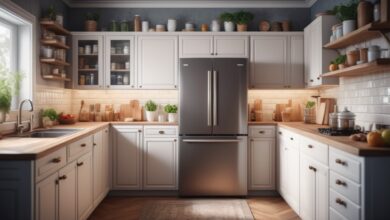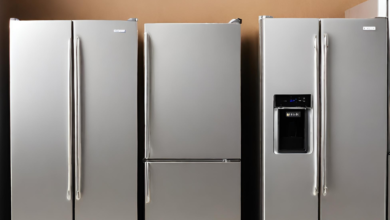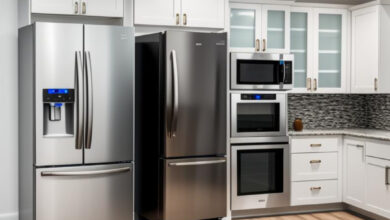How to Measure and Choose the Right Refrigerator for Your Kitchen

Selecting the right refrigerator for your kitchen involves more than just picking a stylish model. It requires a careful consideration of your kitchen space, layout, and personal preferences. In this comprehensive guide, we will delve into the intricacies of measuring and choosing the right refrigerator for your kitchen. From understanding key dimensions to exploring different types and configurations, we’ll provide a step-by-step approach to help you make an informed decision.
Measuring Your Kitchen Space
Before you embark on the journey of choosing a refrigerator, it’s crucial to measure your kitchen space accurately. These measurements will serve as the foundation for finding a refrigerator that not only fits seamlessly but also enhances the overall functionality of your kitchen.
1. Width
Measure the width of the space where you intend to place the refrigerator. Be sure to include any surrounding countertops or cabinets. Note that standard refrigerator widths typically range from 28 to 36 inches. If you have limited space, consider a narrower model or a counter-depth refrigerator for a built-in look.
2. Height
Measure the height from the floor to the ceiling or any overhead cabinets. Ensure there is enough clearance for the refrigerator to fit comfortably. Keep in mind that some refrigerators, especially those with top-mounted freezers, may require additional clearance for the door to swing open fully.
3. Depth
Measure the depth of the space designated for the refrigerator. Take into account the depth of the refrigerator itself and any handles. Standard refrigerator depths range from 28 to 34 inches. If your kitchen layout allows, consider a counter-depth refrigerator to create a sleek and integrated look.
4. Ventilation Clearance
Refrigerators require proper ventilation to function efficiently. Check the manufacturer’s guidelines for ventilation clearance, which is the space needed around the refrigerator for proper air circulation. This clearance is essential for preventing overheating and ensuring optimal performance.
5. Door Swing Clearance
Consider the swing of the refrigerator doors. Measure the space required for the doors to open fully without hitting nearby walls or obstacles. This is especially important for side-by-side or French door configurations, where the door swing can be wider.
Understanding Different Types of Refrigerators
Once you have accurate measurements of your kitchen space, it’s time to explore the different types and configurations of refrigerators available in the market. Each type has its own set of advantages and considerations, catering to various kitchen layouts and lifestyle preferences.
1. Top-Freezer Refrigerators
These classic models have the freezer compartment at the top and the fresh food compartment at the bottom. Top-freezer refrigerators are cost-effective and space-efficient, making them suitable for smaller kitchens.
2. Bottom-Freezer Refrigerators
In bottom-freezer models, the freezer is located at the bottom, providing easy access to fresh food at eye level. These refrigerators often come with a contemporary design and are available in both standard and counter-depth options.
3. Side-by-Side Refrigerators
Featuring two vertical doors that split the refrigerator into fresh food and freezer compartments, side-by-side refrigerators offer good visibility and easy access to both sections. They are suitable for narrow kitchen spaces.
4. French Door Refrigerators
Known for their elegant design, French door refrigerators have two doors for the fresh food compartment and a bottom freezer drawer. They often come with advanced features and are a stylish choice for spacious kitchens.
5. Counter-Depth Refrigerators
Designed to align with standard kitchen cabinets, counter-depth refrigerators provide a built-in look without protruding into the kitchen space. While they may have slightly less storage capacity, they contribute to a seamless appearance.
Matching Refrigerator Size to Family Needs
The size of your family and lifestyle are crucial factors in determining the refrigerator capacity that meets your requirements. Striking the right balance ensures your refrigerator can store food efficiently while accommodating your daily needs.
Consider a standard capacity of 18 to 20 cubic feet for a family of four, and opt for adjustable shelves and storage bins to customize the interior space. Anticipate future needs, especially if your family size is likely to change, and explore refrigerator models that offer flexibility for varying storage requirements.
Energy Efficiency and Environmental Considerations
In an era focused on sustainability, selecting an energy-efficient refrigerator not only reduces your carbon footprint but also results in long-term cost savings. Look for specific features that contribute to energy efficiency.
Ensure the refrigerator is ENERGY STAR certified, indicating compliance with stringent energy efficiency guidelines. Models with inverter compressors adjust their speed based on cooling demand, while LED lighting not only saves energy but also has a longer lifespan compared to traditional bulbs.
Lifestyle and Special Features
Consider your lifestyle and preferences when selecting a refrigerator. Modern appliances offer various features designed to enhance convenience and functionality.
Opt for water and ice dispensers if convenience is a priority, but be mindful of the space they occupy in the door. Explore smart technology features for added convenience and control, and consider a door-in-door design for easy access to frequently used items.
Budget Considerations
While exploring advanced features and designs is exciting, aligning your refrigerator choice with your budget is essential. Consider the total cost of ownership, including energy consumption, to make an informed decision.
Establish a budget range for your refrigerator, prioritizing essential features that match your family’s needs. Keep an eye on seasonal sales and promotions for potential discounts, and explore refurbished or open-box options from reputable retailers to find budget-friendly alternatives without compromising on quality.
Conclusion
Measuring and choosing the right refrigerator for your kitchen is a meticulous process that involves a thoughtful consideration of space, lifestyle, and budget. By understanding your
kitchen dimensions, exploring different types of refrigerators, and aligning your choice with energy efficiency and personal preferences, you can make an informed decision that enhances both the functionality and aesthetics of your kitchen. Remember to measure accurately, prioritize features based on your family’s needs, and stay within your budget to achieve a well-balanced and satisfying result.






